Health Assignment: Improving Sexual Health of Gay and MSM Community
VerifiedAdded on 2023/01/03
|10
|2956
|79
Report
AI Summary
This report, prepared for a health assignment, critically examines the sexual health of the Gay and MSM community, focusing on the prevalence of STIs like Gonorrhoea, Syphilis, and HIV in Australia. It synthesizes evidence from multiple research articles to evaluate interventions aimed at improving sexual health outcomes. The report analyzes studies on Syphilis screening, social marketing campaigns for HIV and STI testing, HIV testing patterns, condom use, and the uptake of PrEP, and HIV incidence. It discusses the barriers to preventive measures and recommends public health programs, including counseling, condom promotion, and PrEP uptake, while emphasizing the importance of patient privacy and healthcare professional ethics to improve health outcomes among the MSM community.
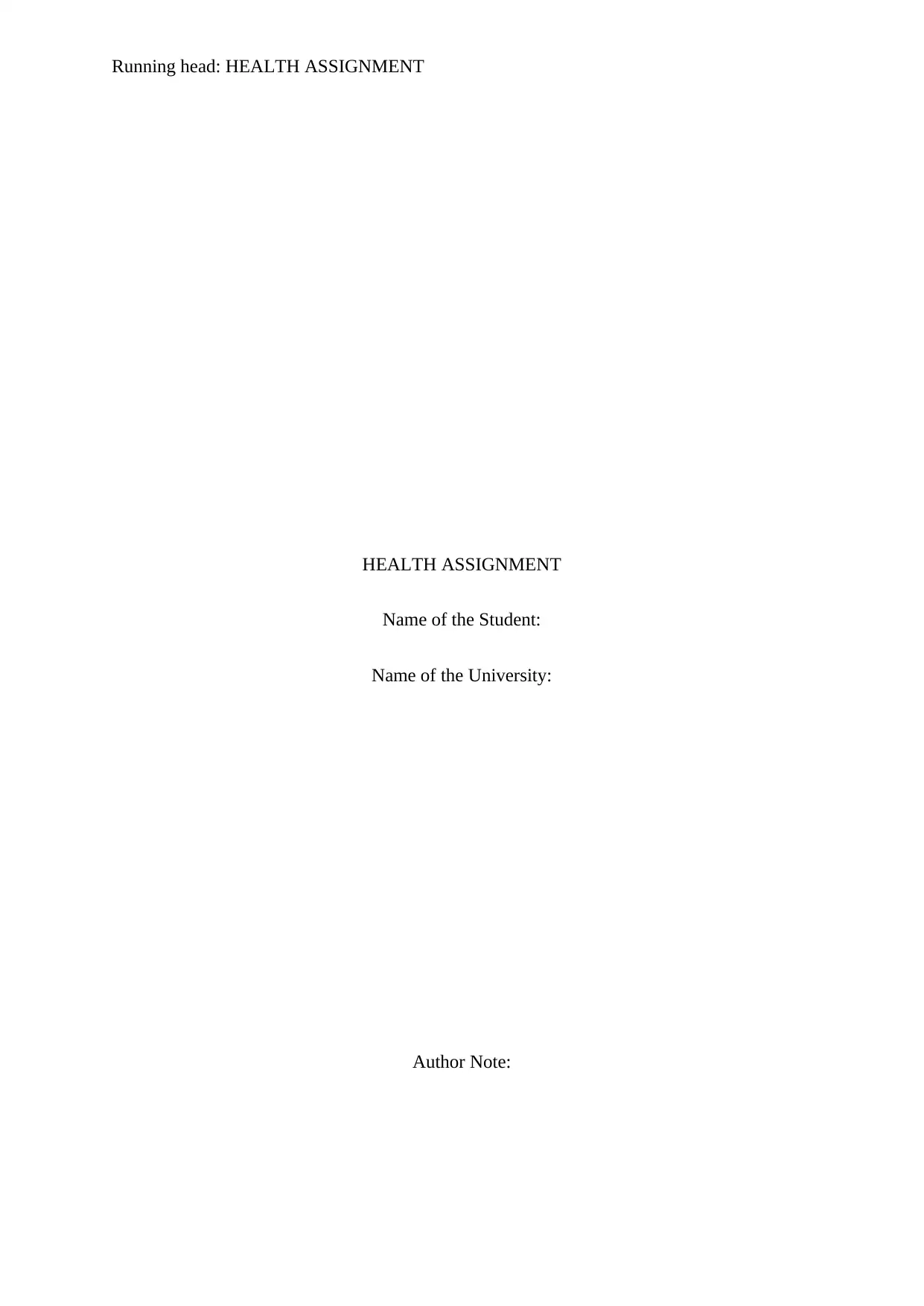
Running head: HEALTH ASSIGNMENT
HEALTH ASSIGNMENT
Name of the Student:
Name of the University:
Author Note:
HEALTH ASSIGNMENT
Name of the Student:
Name of the University:
Author Note:
Paraphrase This Document
Need a fresh take? Get an instant paraphrase of this document with our AI Paraphraser
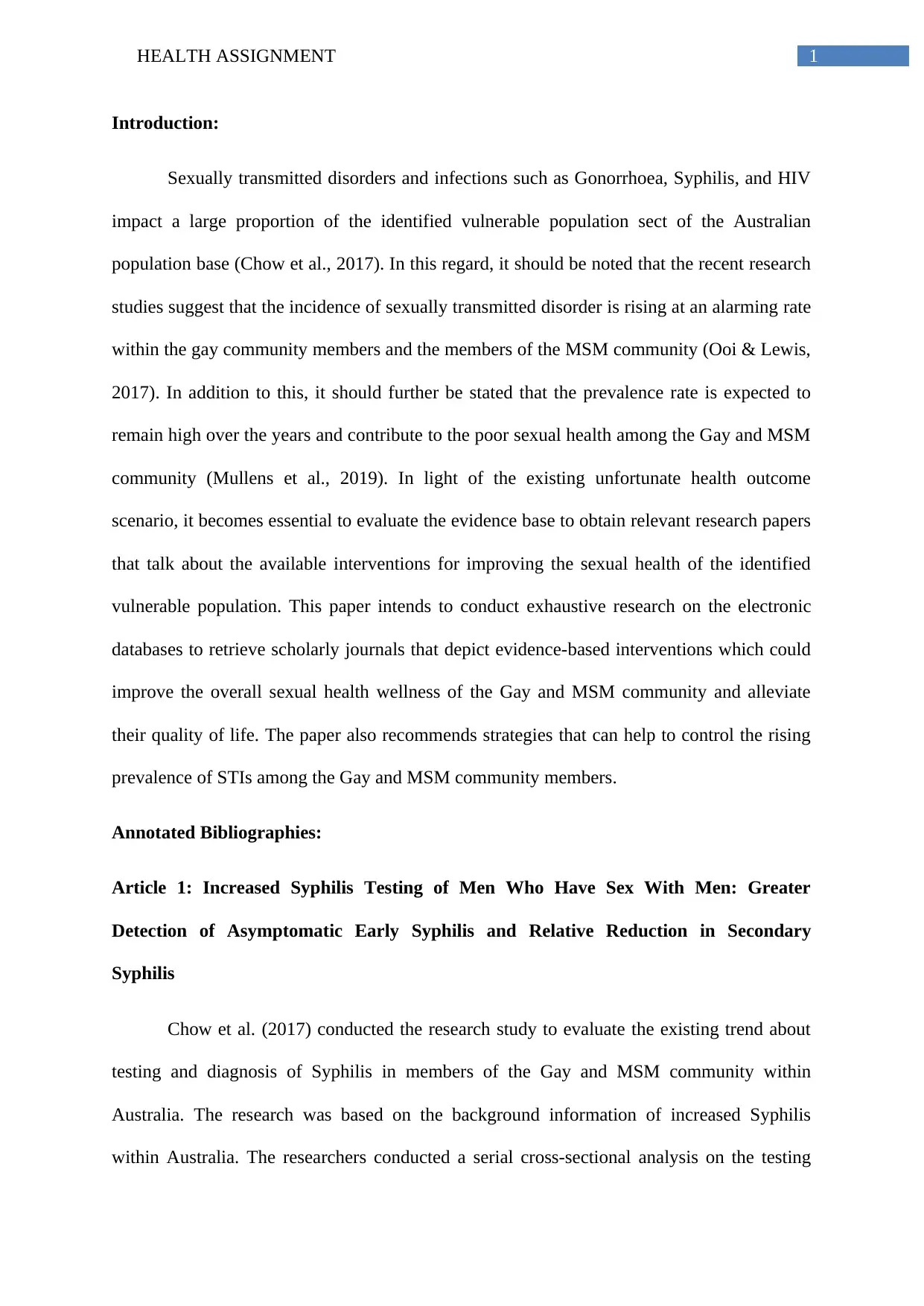
1HEALTH ASSIGNMENT
Introduction:
Sexually transmitted disorders and infections such as Gonorrhoea, Syphilis, and HIV
impact a large proportion of the identified vulnerable population sect of the Australian
population base (Chow et al., 2017). In this regard, it should be noted that the recent research
studies suggest that the incidence of sexually transmitted disorder is rising at an alarming rate
within the gay community members and the members of the MSM community (Ooi & Lewis,
2017). In addition to this, it should further be stated that the prevalence rate is expected to
remain high over the years and contribute to the poor sexual health among the Gay and MSM
community (Mullens et al., 2019). In light of the existing unfortunate health outcome
scenario, it becomes essential to evaluate the evidence base to obtain relevant research papers
that talk about the available interventions for improving the sexual health of the identified
vulnerable population. This paper intends to conduct exhaustive research on the electronic
databases to retrieve scholarly journals that depict evidence-based interventions which could
improve the overall sexual health wellness of the Gay and MSM community and alleviate
their quality of life. The paper also recommends strategies that can help to control the rising
prevalence of STIs among the Gay and MSM community members.
Annotated Bibliographies:
Article 1: Increased Syphilis Testing of Men Who Have Sex With Men: Greater
Detection of Asymptomatic Early Syphilis and Relative Reduction in Secondary
Syphilis
Chow et al. (2017) conducted the research study to evaluate the existing trend about
testing and diagnosis of Syphilis in members of the Gay and MSM community within
Australia. The research was based on the background information of increased Syphilis
within Australia. The researchers conducted a serial cross-sectional analysis on the testing
Introduction:
Sexually transmitted disorders and infections such as Gonorrhoea, Syphilis, and HIV
impact a large proportion of the identified vulnerable population sect of the Australian
population base (Chow et al., 2017). In this regard, it should be noted that the recent research
studies suggest that the incidence of sexually transmitted disorder is rising at an alarming rate
within the gay community members and the members of the MSM community (Ooi & Lewis,
2017). In addition to this, it should further be stated that the prevalence rate is expected to
remain high over the years and contribute to the poor sexual health among the Gay and MSM
community (Mullens et al., 2019). In light of the existing unfortunate health outcome
scenario, it becomes essential to evaluate the evidence base to obtain relevant research papers
that talk about the available interventions for improving the sexual health of the identified
vulnerable population. This paper intends to conduct exhaustive research on the electronic
databases to retrieve scholarly journals that depict evidence-based interventions which could
improve the overall sexual health wellness of the Gay and MSM community and alleviate
their quality of life. The paper also recommends strategies that can help to control the rising
prevalence of STIs among the Gay and MSM community members.
Annotated Bibliographies:
Article 1: Increased Syphilis Testing of Men Who Have Sex With Men: Greater
Detection of Asymptomatic Early Syphilis and Relative Reduction in Secondary
Syphilis
Chow et al. (2017) conducted the research study to evaluate the existing trend about
testing and diagnosis of Syphilis in members of the Gay and MSM community within
Australia. The research was based on the background information of increased Syphilis
within Australia. The researchers conducted a serial cross-sectional analysis on the testing
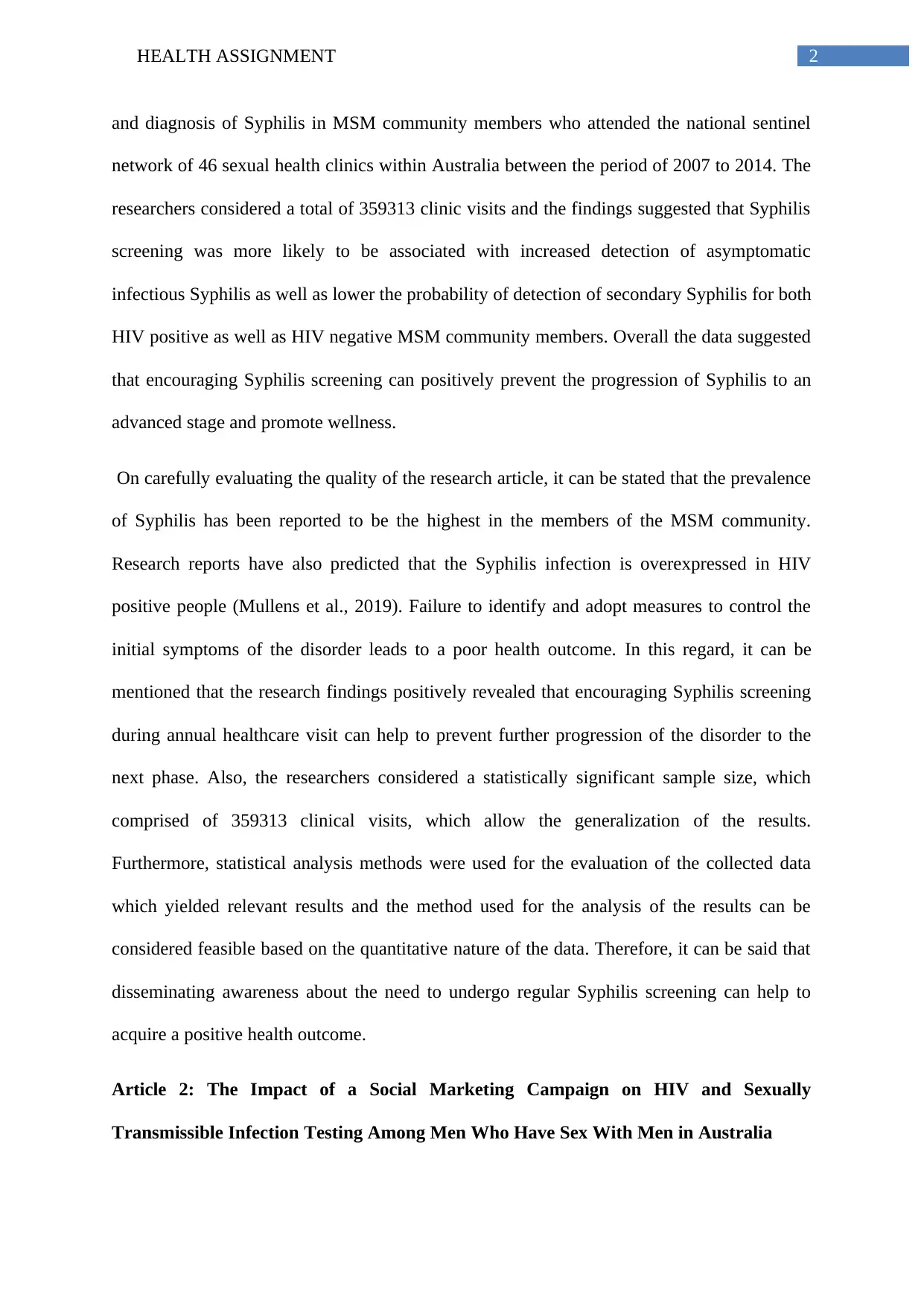
2HEALTH ASSIGNMENT
and diagnosis of Syphilis in MSM community members who attended the national sentinel
network of 46 sexual health clinics within Australia between the period of 2007 to 2014. The
researchers considered a total of 359313 clinic visits and the findings suggested that Syphilis
screening was more likely to be associated with increased detection of asymptomatic
infectious Syphilis as well as lower the probability of detection of secondary Syphilis for both
HIV positive as well as HIV negative MSM community members. Overall the data suggested
that encouraging Syphilis screening can positively prevent the progression of Syphilis to an
advanced stage and promote wellness.
On carefully evaluating the quality of the research article, it can be stated that the prevalence
of Syphilis has been reported to be the highest in the members of the MSM community.
Research reports have also predicted that the Syphilis infection is overexpressed in HIV
positive people (Mullens et al., 2019). Failure to identify and adopt measures to control the
initial symptoms of the disorder leads to a poor health outcome. In this regard, it can be
mentioned that the research findings positively revealed that encouraging Syphilis screening
during annual healthcare visit can help to prevent further progression of the disorder to the
next phase. Also, the researchers considered a statistically significant sample size, which
comprised of 359313 clinical visits, which allow the generalization of the results.
Furthermore, statistical analysis methods were used for the evaluation of the collected data
which yielded relevant results and the method used for the analysis of the results can be
considered feasible based on the quantitative nature of the data. Therefore, it can be said that
disseminating awareness about the need to undergo regular Syphilis screening can help to
acquire a positive health outcome.
Article 2: The Impact of a Social Marketing Campaign on HIV and Sexually
Transmissible Infection Testing Among Men Who Have Sex With Men in Australia
and diagnosis of Syphilis in MSM community members who attended the national sentinel
network of 46 sexual health clinics within Australia between the period of 2007 to 2014. The
researchers considered a total of 359313 clinic visits and the findings suggested that Syphilis
screening was more likely to be associated with increased detection of asymptomatic
infectious Syphilis as well as lower the probability of detection of secondary Syphilis for both
HIV positive as well as HIV negative MSM community members. Overall the data suggested
that encouraging Syphilis screening can positively prevent the progression of Syphilis to an
advanced stage and promote wellness.
On carefully evaluating the quality of the research article, it can be stated that the prevalence
of Syphilis has been reported to be the highest in the members of the MSM community.
Research reports have also predicted that the Syphilis infection is overexpressed in HIV
positive people (Mullens et al., 2019). Failure to identify and adopt measures to control the
initial symptoms of the disorder leads to a poor health outcome. In this regard, it can be
mentioned that the research findings positively revealed that encouraging Syphilis screening
during annual healthcare visit can help to prevent further progression of the disorder to the
next phase. Also, the researchers considered a statistically significant sample size, which
comprised of 359313 clinical visits, which allow the generalization of the results.
Furthermore, statistical analysis methods were used for the evaluation of the collected data
which yielded relevant results and the method used for the analysis of the results can be
considered feasible based on the quantitative nature of the data. Therefore, it can be said that
disseminating awareness about the need to undergo regular Syphilis screening can help to
acquire a positive health outcome.
Article 2: The Impact of a Social Marketing Campaign on HIV and Sexually
Transmissible Infection Testing Among Men Who Have Sex With Men in Australia
⊘ This is a preview!⊘
Do you want full access?
Subscribe today to unlock all pages.

Trusted by 1+ million students worldwide
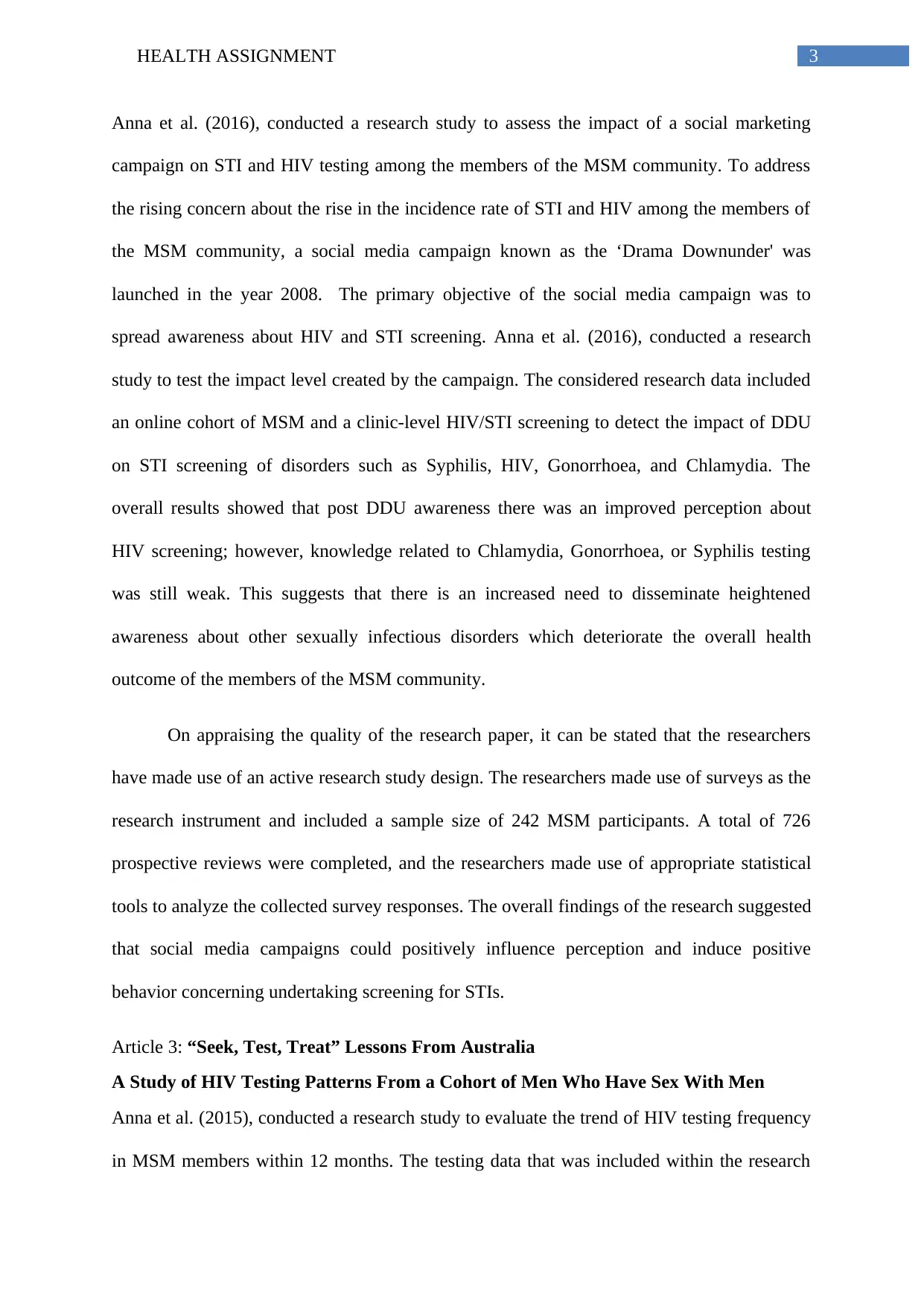
3HEALTH ASSIGNMENT
Anna et al. (2016), conducted a research study to assess the impact of a social marketing
campaign on STI and HIV testing among the members of the MSM community. To address
the rising concern about the rise in the incidence rate of STI and HIV among the members of
the MSM community, a social media campaign known as the ‘Drama Downunder' was
launched in the year 2008. The primary objective of the social media campaign was to
spread awareness about HIV and STI screening. Anna et al. (2016), conducted a research
study to test the impact level created by the campaign. The considered research data included
an online cohort of MSM and a clinic-level HIV/STI screening to detect the impact of DDU
on STI screening of disorders such as Syphilis, HIV, Gonorrhoea, and Chlamydia. The
overall results showed that post DDU awareness there was an improved perception about
HIV screening; however, knowledge related to Chlamydia, Gonorrhoea, or Syphilis testing
was still weak. This suggests that there is an increased need to disseminate heightened
awareness about other sexually infectious disorders which deteriorate the overall health
outcome of the members of the MSM community.
On appraising the quality of the research paper, it can be stated that the researchers
have made use of an active research study design. The researchers made use of surveys as the
research instrument and included a sample size of 242 MSM participants. A total of 726
prospective reviews were completed, and the researchers made use of appropriate statistical
tools to analyze the collected survey responses. The overall findings of the research suggested
that social media campaigns could positively influence perception and induce positive
behavior concerning undertaking screening for STIs.
Article 3: “Seek, Test, Treat” Lessons From Australia
A Study of HIV Testing Patterns From a Cohort of Men Who Have Sex With Men
Anna et al. (2015), conducted a research study to evaluate the trend of HIV testing frequency
in MSM members within 12 months. The testing data that was included within the research
Anna et al. (2016), conducted a research study to assess the impact of a social marketing
campaign on STI and HIV testing among the members of the MSM community. To address
the rising concern about the rise in the incidence rate of STI and HIV among the members of
the MSM community, a social media campaign known as the ‘Drama Downunder' was
launched in the year 2008. The primary objective of the social media campaign was to
spread awareness about HIV and STI screening. Anna et al. (2016), conducted a research
study to test the impact level created by the campaign. The considered research data included
an online cohort of MSM and a clinic-level HIV/STI screening to detect the impact of DDU
on STI screening of disorders such as Syphilis, HIV, Gonorrhoea, and Chlamydia. The
overall results showed that post DDU awareness there was an improved perception about
HIV screening; however, knowledge related to Chlamydia, Gonorrhoea, or Syphilis testing
was still weak. This suggests that there is an increased need to disseminate heightened
awareness about other sexually infectious disorders which deteriorate the overall health
outcome of the members of the MSM community.
On appraising the quality of the research paper, it can be stated that the researchers
have made use of an active research study design. The researchers made use of surveys as the
research instrument and included a sample size of 242 MSM participants. A total of 726
prospective reviews were completed, and the researchers made use of appropriate statistical
tools to analyze the collected survey responses. The overall findings of the research suggested
that social media campaigns could positively influence perception and induce positive
behavior concerning undertaking screening for STIs.
Article 3: “Seek, Test, Treat” Lessons From Australia
A Study of HIV Testing Patterns From a Cohort of Men Who Have Sex With Men
Anna et al. (2015), conducted a research study to evaluate the trend of HIV testing frequency
in MSM members within 12 months. The testing data that was included within the research
Paraphrase This Document
Need a fresh take? Get an instant paraphrase of this document with our AI Paraphraser
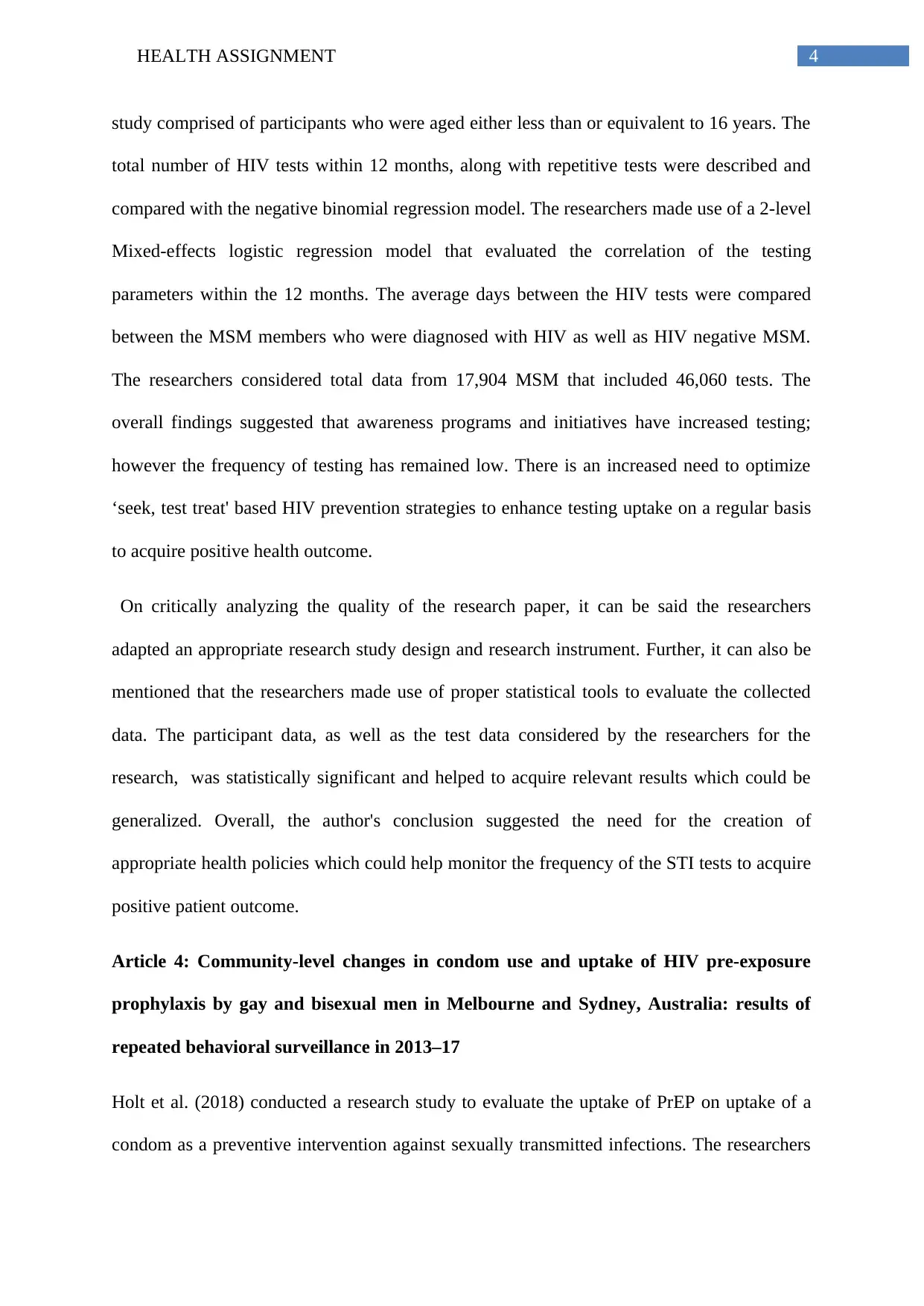
4HEALTH ASSIGNMENT
study comprised of participants who were aged either less than or equivalent to 16 years. The
total number of HIV tests within 12 months, along with repetitive tests were described and
compared with the negative binomial regression model. The researchers made use of a 2-level
Mixed-effects logistic regression model that evaluated the correlation of the testing
parameters within the 12 months. The average days between the HIV tests were compared
between the MSM members who were diagnosed with HIV as well as HIV negative MSM.
The researchers considered total data from 17,904 MSM that included 46,060 tests. The
overall findings suggested that awareness programs and initiatives have increased testing;
however the frequency of testing has remained low. There is an increased need to optimize
‘seek, test treat' based HIV prevention strategies to enhance testing uptake on a regular basis
to acquire positive health outcome.
On critically analyzing the quality of the research paper, it can be said the researchers
adapted an appropriate research study design and research instrument. Further, it can also be
mentioned that the researchers made use of proper statistical tools to evaluate the collected
data. The participant data, as well as the test data considered by the researchers for the
research, was statistically significant and helped to acquire relevant results which could be
generalized. Overall, the author's conclusion suggested the need for the creation of
appropriate health policies which could help monitor the frequency of the STI tests to acquire
positive patient outcome.
Article 4: Community-level changes in condom use and uptake of HIV pre-exposure
prophylaxis by gay and bisexual men in Melbourne and Sydney, Australia: results of
repeated behavioral surveillance in 2013–17
Holt et al. (2018) conducted a research study to evaluate the uptake of PrEP on uptake of a
condom as a preventive intervention against sexually transmitted infections. The researchers
study comprised of participants who were aged either less than or equivalent to 16 years. The
total number of HIV tests within 12 months, along with repetitive tests were described and
compared with the negative binomial regression model. The researchers made use of a 2-level
Mixed-effects logistic regression model that evaluated the correlation of the testing
parameters within the 12 months. The average days between the HIV tests were compared
between the MSM members who were diagnosed with HIV as well as HIV negative MSM.
The researchers considered total data from 17,904 MSM that included 46,060 tests. The
overall findings suggested that awareness programs and initiatives have increased testing;
however the frequency of testing has remained low. There is an increased need to optimize
‘seek, test treat' based HIV prevention strategies to enhance testing uptake on a regular basis
to acquire positive health outcome.
On critically analyzing the quality of the research paper, it can be said the researchers
adapted an appropriate research study design and research instrument. Further, it can also be
mentioned that the researchers made use of proper statistical tools to evaluate the collected
data. The participant data, as well as the test data considered by the researchers for the
research, was statistically significant and helped to acquire relevant results which could be
generalized. Overall, the author's conclusion suggested the need for the creation of
appropriate health policies which could help monitor the frequency of the STI tests to acquire
positive patient outcome.
Article 4: Community-level changes in condom use and uptake of HIV pre-exposure
prophylaxis by gay and bisexual men in Melbourne and Sydney, Australia: results of
repeated behavioral surveillance in 2013–17
Holt et al. (2018) conducted a research study to evaluate the uptake of PrEP on uptake of a
condom as a preventive intervention against sexually transmitted infections. The researchers
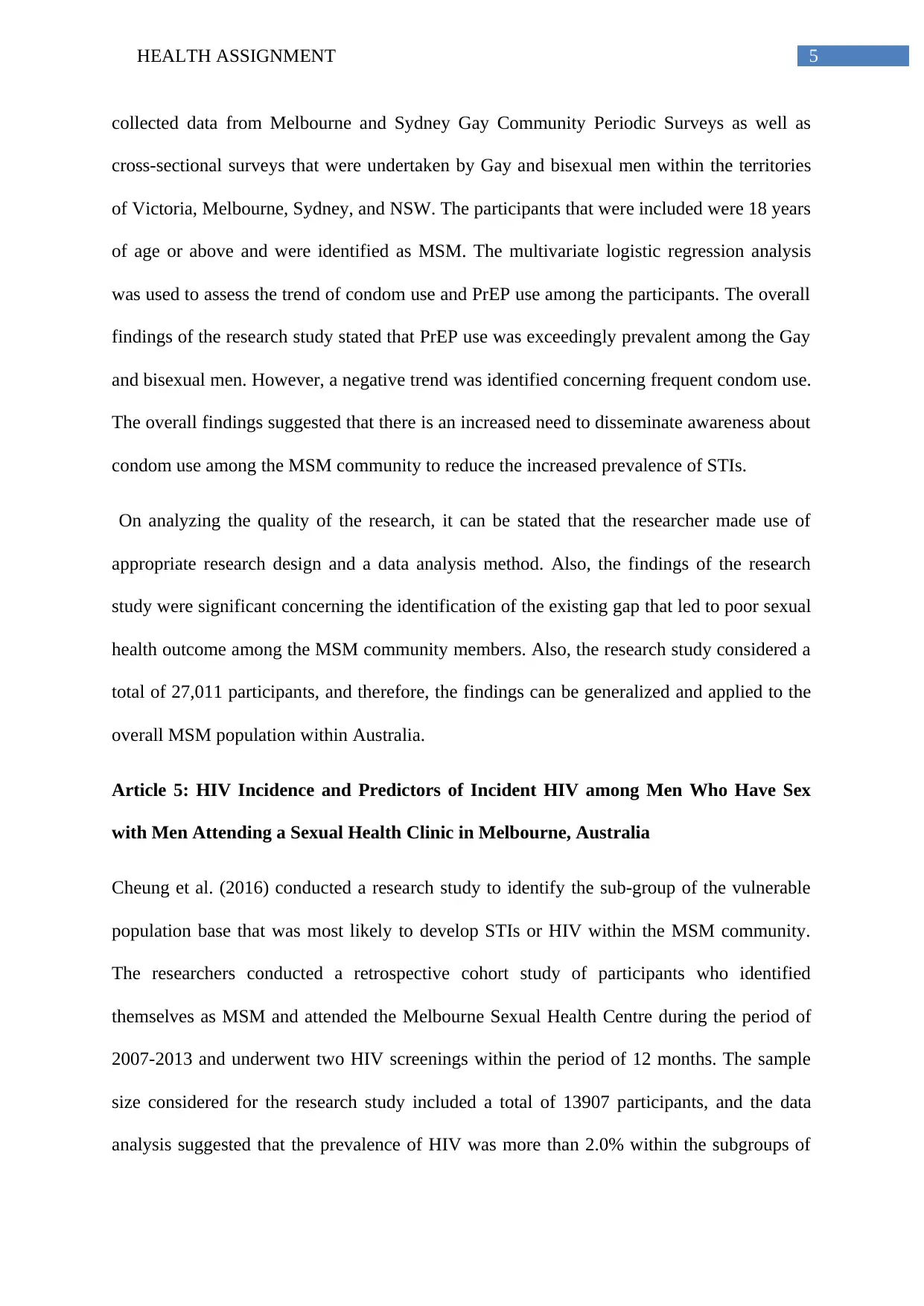
5HEALTH ASSIGNMENT
collected data from Melbourne and Sydney Gay Community Periodic Surveys as well as
cross-sectional surveys that were undertaken by Gay and bisexual men within the territories
of Victoria, Melbourne, Sydney, and NSW. The participants that were included were 18 years
of age or above and were identified as MSM. The multivariate logistic regression analysis
was used to assess the trend of condom use and PrEP use among the participants. The overall
findings of the research study stated that PrEP use was exceedingly prevalent among the Gay
and bisexual men. However, a negative trend was identified concerning frequent condom use.
The overall findings suggested that there is an increased need to disseminate awareness about
condom use among the MSM community to reduce the increased prevalence of STIs.
On analyzing the quality of the research, it can be stated that the researcher made use of
appropriate research design and a data analysis method. Also, the findings of the research
study were significant concerning the identification of the existing gap that led to poor sexual
health outcome among the MSM community members. Also, the research study considered a
total of 27,011 participants, and therefore, the findings can be generalized and applied to the
overall MSM population within Australia.
Article 5: HIV Incidence and Predictors of Incident HIV among Men Who Have Sex
with Men Attending a Sexual Health Clinic in Melbourne, Australia
Cheung et al. (2016) conducted a research study to identify the sub-group of the vulnerable
population base that was most likely to develop STIs or HIV within the MSM community.
The researchers conducted a retrospective cohort study of participants who identified
themselves as MSM and attended the Melbourne Sexual Health Centre during the period of
2007-2013 and underwent two HIV screenings within the period of 12 months. The sample
size considered for the research study included a total of 13907 participants, and the data
analysis suggested that the prevalence of HIV was more than 2.0% within the subgroups of
collected data from Melbourne and Sydney Gay Community Periodic Surveys as well as
cross-sectional surveys that were undertaken by Gay and bisexual men within the territories
of Victoria, Melbourne, Sydney, and NSW. The participants that were included were 18 years
of age or above and were identified as MSM. The multivariate logistic regression analysis
was used to assess the trend of condom use and PrEP use among the participants. The overall
findings of the research study stated that PrEP use was exceedingly prevalent among the Gay
and bisexual men. However, a negative trend was identified concerning frequent condom use.
The overall findings suggested that there is an increased need to disseminate awareness about
condom use among the MSM community to reduce the increased prevalence of STIs.
On analyzing the quality of the research, it can be stated that the researcher made use of
appropriate research design and a data analysis method. Also, the findings of the research
study were significant concerning the identification of the existing gap that led to poor sexual
health outcome among the MSM community members. Also, the research study considered a
total of 27,011 participants, and therefore, the findings can be generalized and applied to the
overall MSM population within Australia.
Article 5: HIV Incidence and Predictors of Incident HIV among Men Who Have Sex
with Men Attending a Sexual Health Clinic in Melbourne, Australia
Cheung et al. (2016) conducted a research study to identify the sub-group of the vulnerable
population base that was most likely to develop STIs or HIV within the MSM community.
The researchers conducted a retrospective cohort study of participants who identified
themselves as MSM and attended the Melbourne Sexual Health Centre during the period of
2007-2013 and underwent two HIV screenings within the period of 12 months. The sample
size considered for the research study included a total of 13907 participants, and the data
analysis suggested that the prevalence of HIV was more than 2.0% within the subgroups of
⊘ This is a preview!⊘
Do you want full access?
Subscribe today to unlock all pages.

Trusted by 1+ million students worldwide
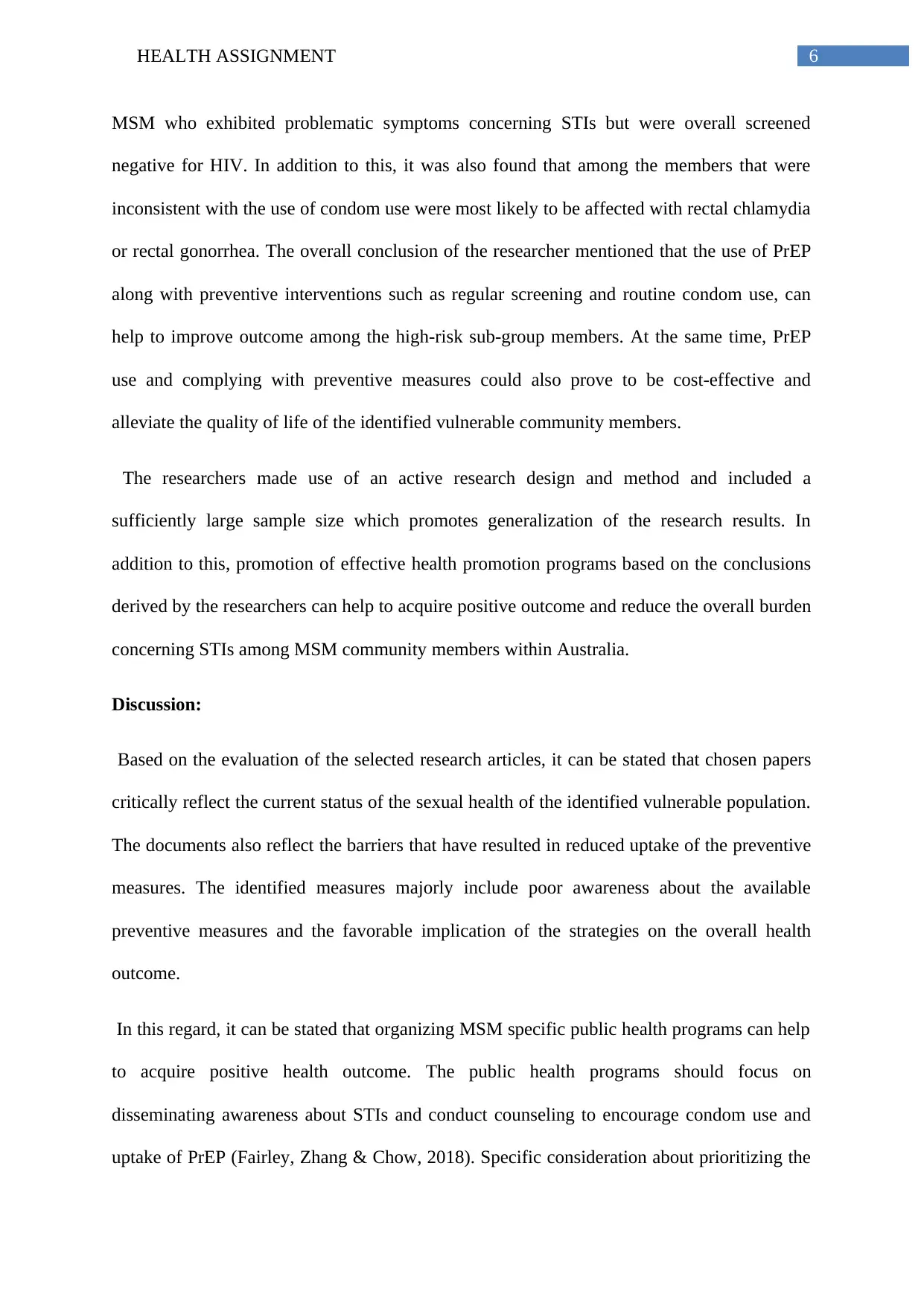
6HEALTH ASSIGNMENT
MSM who exhibited problematic symptoms concerning STIs but were overall screened
negative for HIV. In addition to this, it was also found that among the members that were
inconsistent with the use of condom use were most likely to be affected with rectal chlamydia
or rectal gonorrhea. The overall conclusion of the researcher mentioned that the use of PrEP
along with preventive interventions such as regular screening and routine condom use, can
help to improve outcome among the high-risk sub-group members. At the same time, PrEP
use and complying with preventive measures could also prove to be cost-effective and
alleviate the quality of life of the identified vulnerable community members.
The researchers made use of an active research design and method and included a
sufficiently large sample size which promotes generalization of the research results. In
addition to this, promotion of effective health promotion programs based on the conclusions
derived by the researchers can help to acquire positive outcome and reduce the overall burden
concerning STIs among MSM community members within Australia.
Discussion:
Based on the evaluation of the selected research articles, it can be stated that chosen papers
critically reflect the current status of the sexual health of the identified vulnerable population.
The documents also reflect the barriers that have resulted in reduced uptake of the preventive
measures. The identified measures majorly include poor awareness about the available
preventive measures and the favorable implication of the strategies on the overall health
outcome.
In this regard, it can be stated that organizing MSM specific public health programs can help
to acquire positive health outcome. The public health programs should focus on
disseminating awareness about STIs and conduct counseling to encourage condom use and
uptake of PrEP (Fairley, Zhang & Chow, 2018). Specific consideration about prioritizing the
MSM who exhibited problematic symptoms concerning STIs but were overall screened
negative for HIV. In addition to this, it was also found that among the members that were
inconsistent with the use of condom use were most likely to be affected with rectal chlamydia
or rectal gonorrhea. The overall conclusion of the researcher mentioned that the use of PrEP
along with preventive interventions such as regular screening and routine condom use, can
help to improve outcome among the high-risk sub-group members. At the same time, PrEP
use and complying with preventive measures could also prove to be cost-effective and
alleviate the quality of life of the identified vulnerable community members.
The researchers made use of an active research design and method and included a
sufficiently large sample size which promotes generalization of the research results. In
addition to this, promotion of effective health promotion programs based on the conclusions
derived by the researchers can help to acquire positive outcome and reduce the overall burden
concerning STIs among MSM community members within Australia.
Discussion:
Based on the evaluation of the selected research articles, it can be stated that chosen papers
critically reflect the current status of the sexual health of the identified vulnerable population.
The documents also reflect the barriers that have resulted in reduced uptake of the preventive
measures. The identified measures majorly include poor awareness about the available
preventive measures and the favorable implication of the strategies on the overall health
outcome.
In this regard, it can be stated that organizing MSM specific public health programs can help
to acquire positive health outcome. The public health programs should focus on
disseminating awareness about STIs and conduct counseling to encourage condom use and
uptake of PrEP (Fairley, Zhang & Chow, 2018). Specific consideration about prioritizing the
Paraphrase This Document
Need a fresh take? Get an instant paraphrase of this document with our AI Paraphraser
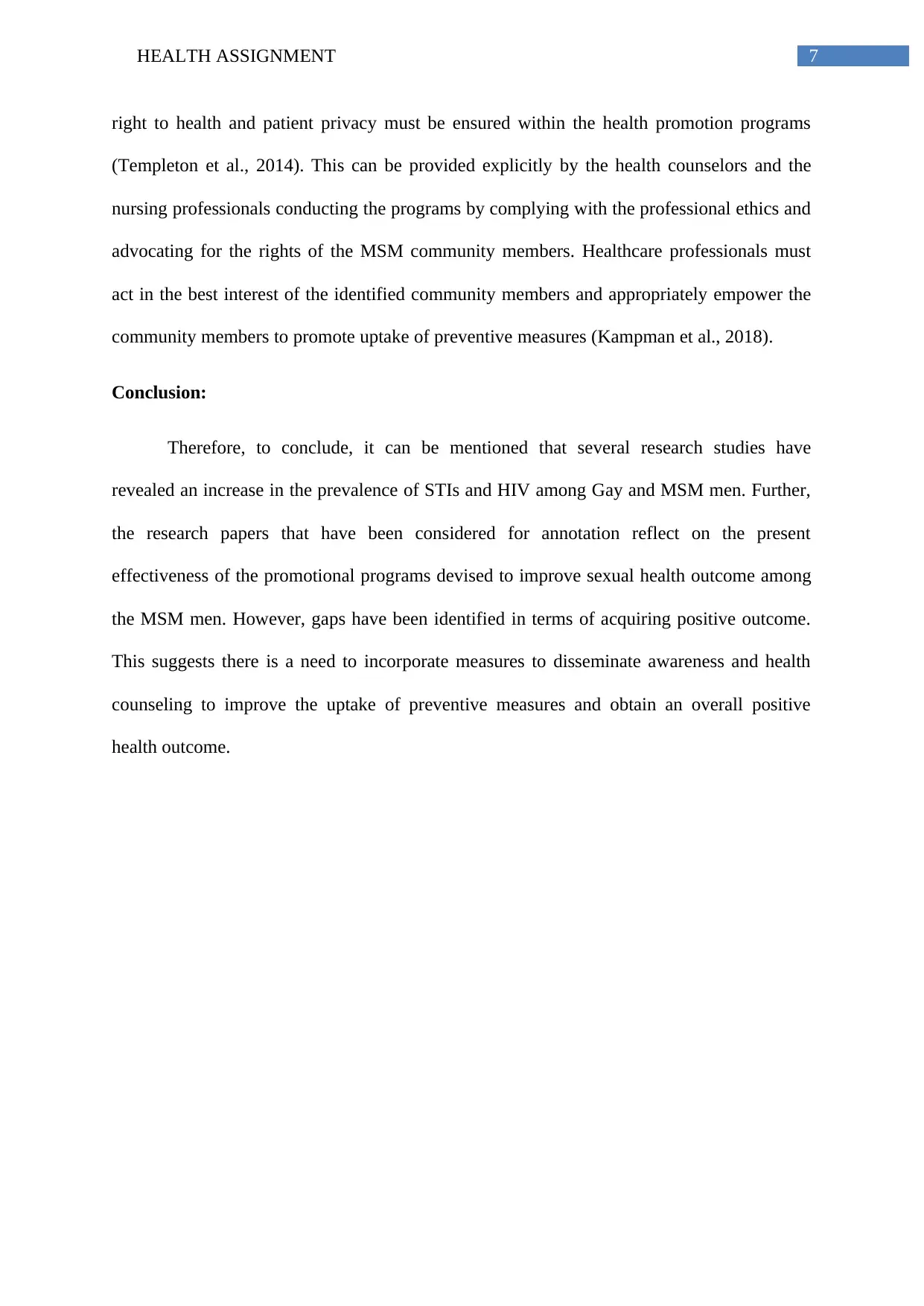
7HEALTH ASSIGNMENT
right to health and patient privacy must be ensured within the health promotion programs
(Templeton et al., 2014). This can be provided explicitly by the health counselors and the
nursing professionals conducting the programs by complying with the professional ethics and
advocating for the rights of the MSM community members. Healthcare professionals must
act in the best interest of the identified community members and appropriately empower the
community members to promote uptake of preventive measures (Kampman et al., 2018).
Conclusion:
Therefore, to conclude, it can be mentioned that several research studies have
revealed an increase in the prevalence of STIs and HIV among Gay and MSM men. Further,
the research papers that have been considered for annotation reflect on the present
effectiveness of the promotional programs devised to improve sexual health outcome among
the MSM men. However, gaps have been identified in terms of acquiring positive outcome.
This suggests there is a need to incorporate measures to disseminate awareness and health
counseling to improve the uptake of preventive measures and obtain an overall positive
health outcome.
right to health and patient privacy must be ensured within the health promotion programs
(Templeton et al., 2014). This can be provided explicitly by the health counselors and the
nursing professionals conducting the programs by complying with the professional ethics and
advocating for the rights of the MSM community members. Healthcare professionals must
act in the best interest of the identified community members and appropriately empower the
community members to promote uptake of preventive measures (Kampman et al., 2018).
Conclusion:
Therefore, to conclude, it can be mentioned that several research studies have
revealed an increase in the prevalence of STIs and HIV among Gay and MSM men. Further,
the research papers that have been considered for annotation reflect on the present
effectiveness of the promotional programs devised to improve sexual health outcome among
the MSM men. However, gaps have been identified in terms of acquiring positive outcome.
This suggests there is a need to incorporate measures to disseminate awareness and health
counseling to improve the uptake of preventive measures and obtain an overall positive
health outcome.
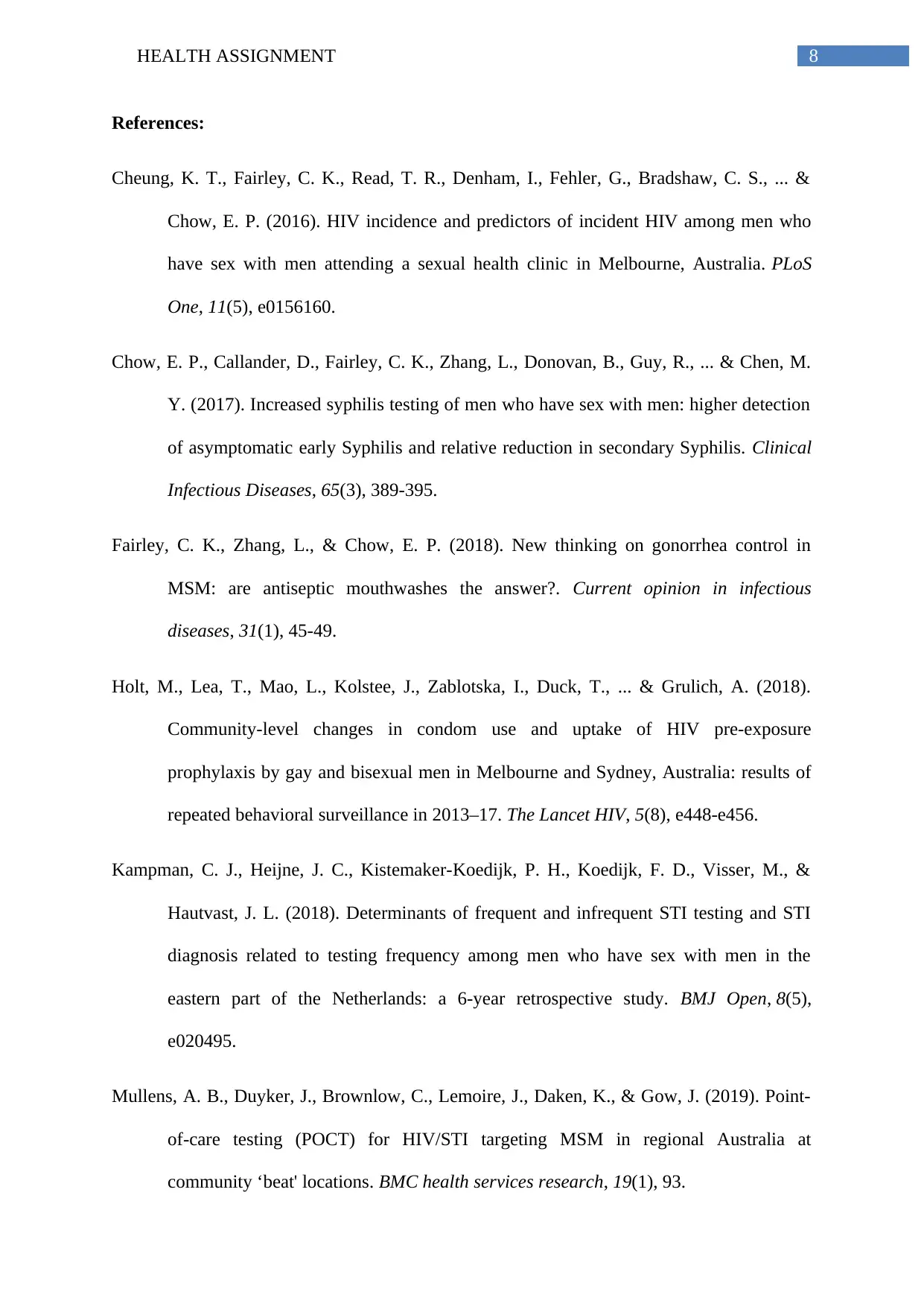
8HEALTH ASSIGNMENT
References:
Cheung, K. T., Fairley, C. K., Read, T. R., Denham, I., Fehler, G., Bradshaw, C. S., ... &
Chow, E. P. (2016). HIV incidence and predictors of incident HIV among men who
have sex with men attending a sexual health clinic in Melbourne, Australia. PLoS
One, 11(5), e0156160.
Chow, E. P., Callander, D., Fairley, C. K., Zhang, L., Donovan, B., Guy, R., ... & Chen, M.
Y. (2017). Increased syphilis testing of men who have sex with men: higher detection
of asymptomatic early Syphilis and relative reduction in secondary Syphilis. Clinical
Infectious Diseases, 65(3), 389-395.
Fairley, C. K., Zhang, L., & Chow, E. P. (2018). New thinking on gonorrhea control in
MSM: are antiseptic mouthwashes the answer?. Current opinion in infectious
diseases, 31(1), 45-49.
Holt, M., Lea, T., Mao, L., Kolstee, J., Zablotska, I., Duck, T., ... & Grulich, A. (2018).
Community-level changes in condom use and uptake of HIV pre-exposure
prophylaxis by gay and bisexual men in Melbourne and Sydney, Australia: results of
repeated behavioral surveillance in 2013–17. The Lancet HIV, 5(8), e448-e456.
Kampman, C. J., Heijne, J. C., Kistemaker-Koedijk, P. H., Koedijk, F. D., Visser, M., &
Hautvast, J. L. (2018). Determinants of frequent and infrequent STI testing and STI
diagnosis related to testing frequency among men who have sex with men in the
eastern part of the Netherlands: a 6-year retrospective study. BMJ Open, 8(5),
e020495.
Mullens, A. B., Duyker, J., Brownlow, C., Lemoire, J., Daken, K., & Gow, J. (2019). Point-
of-care testing (POCT) for HIV/STI targeting MSM in regional Australia at
community ‘beat' locations. BMC health services research, 19(1), 93.
References:
Cheung, K. T., Fairley, C. K., Read, T. R., Denham, I., Fehler, G., Bradshaw, C. S., ... &
Chow, E. P. (2016). HIV incidence and predictors of incident HIV among men who
have sex with men attending a sexual health clinic in Melbourne, Australia. PLoS
One, 11(5), e0156160.
Chow, E. P., Callander, D., Fairley, C. K., Zhang, L., Donovan, B., Guy, R., ... & Chen, M.
Y. (2017). Increased syphilis testing of men who have sex with men: higher detection
of asymptomatic early Syphilis and relative reduction in secondary Syphilis. Clinical
Infectious Diseases, 65(3), 389-395.
Fairley, C. K., Zhang, L., & Chow, E. P. (2018). New thinking on gonorrhea control in
MSM: are antiseptic mouthwashes the answer?. Current opinion in infectious
diseases, 31(1), 45-49.
Holt, M., Lea, T., Mao, L., Kolstee, J., Zablotska, I., Duck, T., ... & Grulich, A. (2018).
Community-level changes in condom use and uptake of HIV pre-exposure
prophylaxis by gay and bisexual men in Melbourne and Sydney, Australia: results of
repeated behavioral surveillance in 2013–17. The Lancet HIV, 5(8), e448-e456.
Kampman, C. J., Heijne, J. C., Kistemaker-Koedijk, P. H., Koedijk, F. D., Visser, M., &
Hautvast, J. L. (2018). Determinants of frequent and infrequent STI testing and STI
diagnosis related to testing frequency among men who have sex with men in the
eastern part of the Netherlands: a 6-year retrospective study. BMJ Open, 8(5),
e020495.
Mullens, A. B., Duyker, J., Brownlow, C., Lemoire, J., Daken, K., & Gow, J. (2019). Point-
of-care testing (POCT) for HIV/STI targeting MSM in regional Australia at
community ‘beat' locations. BMC health services research, 19(1), 93.
⊘ This is a preview!⊘
Do you want full access?
Subscribe today to unlock all pages.

Trusted by 1+ million students worldwide
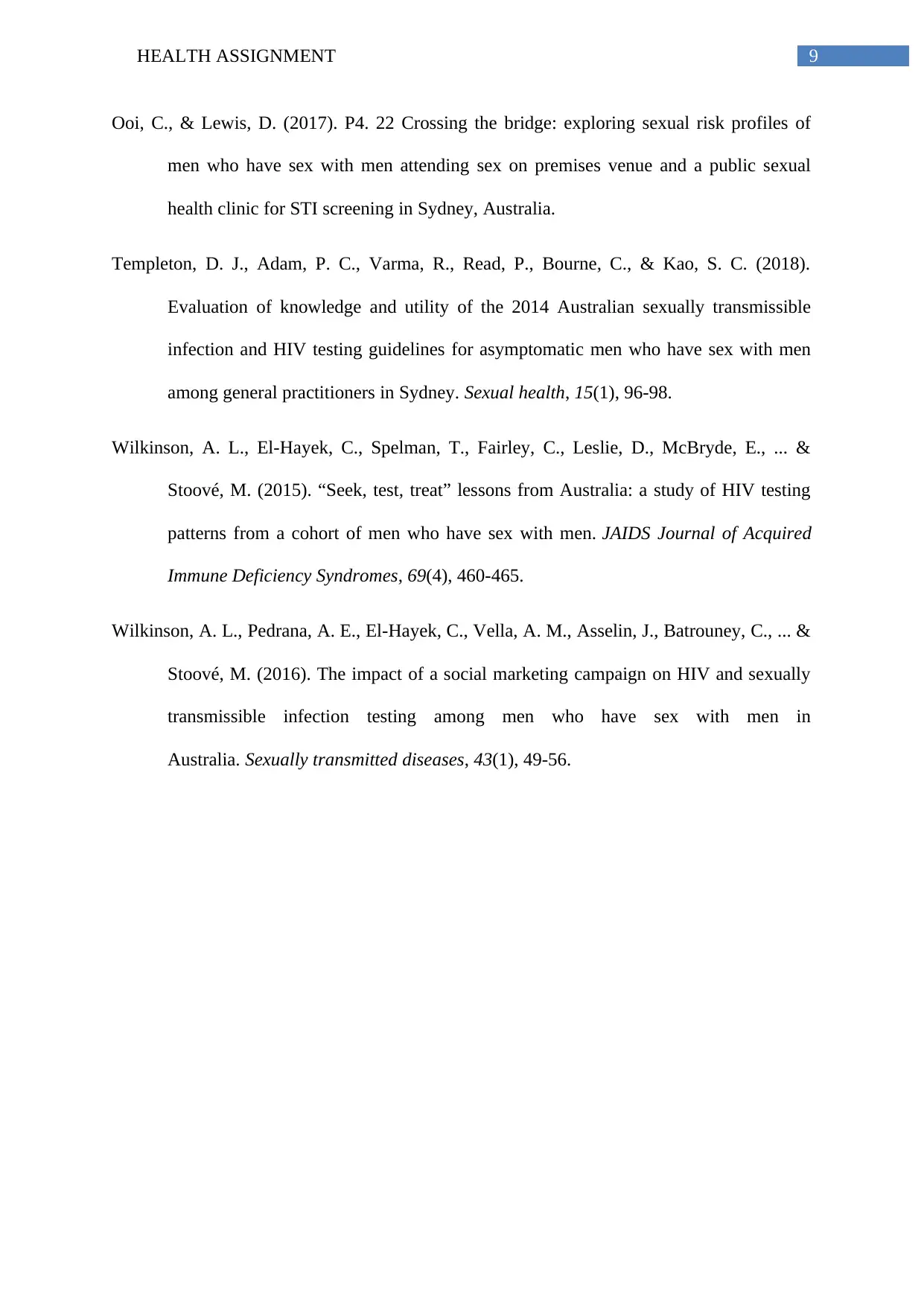
9HEALTH ASSIGNMENT
Ooi, C., & Lewis, D. (2017). P4. 22 Crossing the bridge: exploring sexual risk profiles of
men who have sex with men attending sex on premises venue and a public sexual
health clinic for STI screening in Sydney, Australia.
Templeton, D. J., Adam, P. C., Varma, R., Read, P., Bourne, C., & Kao, S. C. (2018).
Evaluation of knowledge and utility of the 2014 Australian sexually transmissible
infection and HIV testing guidelines for asymptomatic men who have sex with men
among general practitioners in Sydney. Sexual health, 15(1), 96-98.
Wilkinson, A. L., El-Hayek, C., Spelman, T., Fairley, C., Leslie, D., McBryde, E., ... &
Stoové, M. (2015). “Seek, test, treat” lessons from Australia: a study of HIV testing
patterns from a cohort of men who have sex with men. JAIDS Journal of Acquired
Immune Deficiency Syndromes, 69(4), 460-465.
Wilkinson, A. L., Pedrana, A. E., El-Hayek, C., Vella, A. M., Asselin, J., Batrouney, C., ... &
Stoové, M. (2016). The impact of a social marketing campaign on HIV and sexually
transmissible infection testing among men who have sex with men in
Australia. Sexually transmitted diseases, 43(1), 49-56.
Ooi, C., & Lewis, D. (2017). P4. 22 Crossing the bridge: exploring sexual risk profiles of
men who have sex with men attending sex on premises venue and a public sexual
health clinic for STI screening in Sydney, Australia.
Templeton, D. J., Adam, P. C., Varma, R., Read, P., Bourne, C., & Kao, S. C. (2018).
Evaluation of knowledge and utility of the 2014 Australian sexually transmissible
infection and HIV testing guidelines for asymptomatic men who have sex with men
among general practitioners in Sydney. Sexual health, 15(1), 96-98.
Wilkinson, A. L., El-Hayek, C., Spelman, T., Fairley, C., Leslie, D., McBryde, E., ... &
Stoové, M. (2015). “Seek, test, treat” lessons from Australia: a study of HIV testing
patterns from a cohort of men who have sex with men. JAIDS Journal of Acquired
Immune Deficiency Syndromes, 69(4), 460-465.
Wilkinson, A. L., Pedrana, A. E., El-Hayek, C., Vella, A. M., Asselin, J., Batrouney, C., ... &
Stoové, M. (2016). The impact of a social marketing campaign on HIV and sexually
transmissible infection testing among men who have sex with men in
Australia. Sexually transmitted diseases, 43(1), 49-56.
1 out of 10
Related Documents
Your All-in-One AI-Powered Toolkit for Academic Success.
+13062052269
info@desklib.com
Available 24*7 on WhatsApp / Email
![[object Object]](/_next/static/media/star-bottom.7253800d.svg)
Unlock your academic potential
Copyright © 2020–2025 A2Z Services. All Rights Reserved. Developed and managed by ZUCOL.





